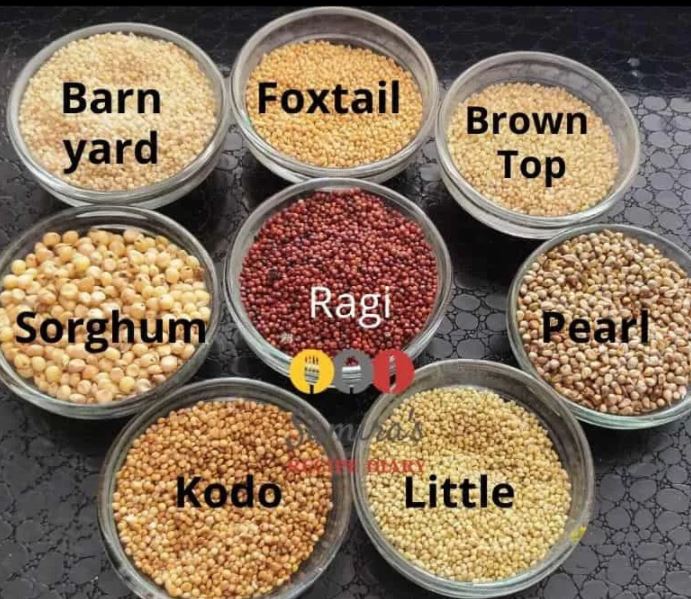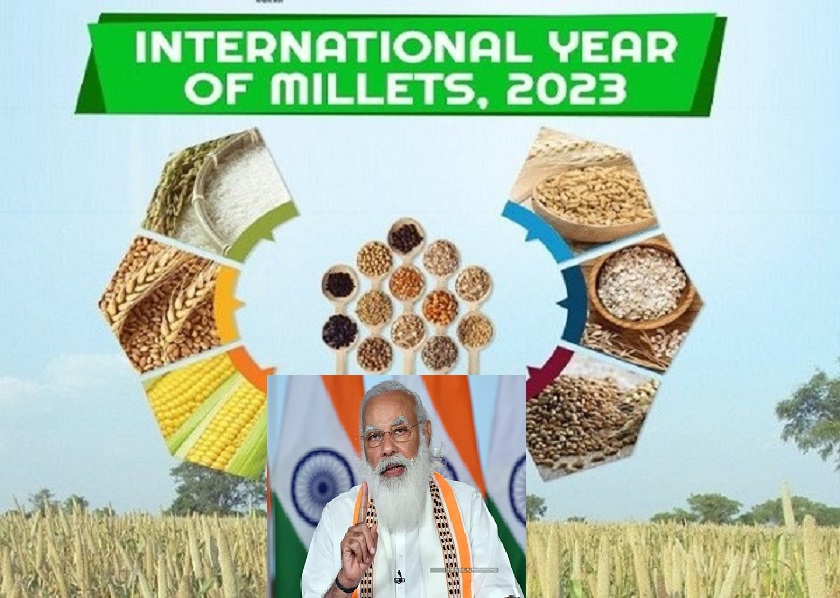During the recently concluded Mann Ki Baat, PM Narendra Modi stated that the craze for coarse grains/ millets is rising around the world every year. The U.N. General Assembly on April 2021 adopted a resolution sponsored by India declaring 2023 as the International Year of Millets.
Introduction
Millets comprise 9 different crops eaten as a staple food in parts of Africa, India and China since ancient times. Yet, they became the forgotten super-food of India. Wheat and rice displaced the cultivation of millets. But gradually their miraculous qualities are being rediscovered and hopefully, millets will regain their past glory. They have been branded as ‘Nutri-Cereal’ by the government of India. Their widespread use will help reduce the carbon footprint in countries where its cultivation is increased. The economy of those countries will also benefit.
Children are getting khus and quinoa in midday meals in the developed world. These staples are gluten-free yet nutritious. But the ‘Gym Revolution’ and multiplication of ‘Dieticians/ Nutritionists’ in India promoted speciality diets like high protein diets, speciality diets for the obese, diabetics, hypertensives and gluten-free diets. These were packaged and supplied at very high costs. PepsiCo brought Quaker oats to India and the other breakfast companies repackaged corn and other cereal flakes in various flavours with high sugar content.
History
Historically, millets find mentioned in the Yajurveda. As per ethnobotanists, wheat cultivation started after millets. Rice, however, was grown in places with abundant rainfall. Millets grew well in arid areas too. In the decade of 1960s, a series of severe droughts hit India. This led to the arrival of wheat from the US under the ‘PL 480’ scheme. India’s public distribution system had wheat, rice and sugar but our own millets were forgotten.
The green revolution solved most of the hunger problems of the country. The output of wheat trebled 50 years after it was launched. Rice production increased by an astronomical five times! Government subsidies of fertilisers and pesticides, free electricity and canal waters added with a minimum support price for these crops were also the factors responsible for farmers giving up growing millets in favour of wheat and rice. The fast-paced life of this century and multimedia promotions led to children and young adults taking to burgers and pizza followed by pastries and icecreams.
Millets were neither grown, eaten nor researched by the western scientists of the world as these grasses didn’t grow in their countries. The nutritional benefits of millets could not be discovered by the research fellows of the millet growing under-developed Asian and African countries. Hence, these staples were left to be eaten by the ‘Adivasis’ and other tribals in India. The urban people considered them bird feed and used it in religious rituals and ceremonies.
Types
Millets are small-seeded ‘annual’ grasses grown and eaten in 31 countries as staples. There are nine types of millets in India of which four are grown in many parts of India. These are as follows:
- Sorghum or Jowar.
- Pearl Millet or Bajra.
- Finger Millet or Ragi.
- Foxtail Millet or Kangni.
Others are Little millet, Barnyard millet, Proso, Kodo and Browntop millet. These are grown and eaten in lesser parts of the country.

Major Benefits and Carbon Footprint
Millets have numerous benefits other than a food supplement. It is a good animal /bird feed, can be used as a biofuel and needs less water to grow.
Water conservation is a major advantage for the cultivation of millets for food over wheat and rice. The carbon footprint is much less than millets. Wheat is more but rice including Basmati is much higher. Many of the nine millets require needs 2.5 times less water than rice/wheat, much less or no requirement for chemical fertilisers and pesticides, shorter period of cultivation in fields. Besides causing a lesser carbon footprint, it gives more time to farmers for tending to other jobs for a second income.
Can grow in soils of arid regions or even soils rendered saline by excessive cultivation of crops requiring more water for their growth. Millets can also grow in hilly areas without much preparation for step farming. This year’s wheat crop output is less because of 40°C temperatures during its ripening period in April. With global warming looming large, it is feared that the output may be less in years of high temperatures. Millets can survive temperatures of around 46°C. Millets are thus, the hope for the future.
If we revisit the above factors, the millet crops can be grown faster and with much fewer inputs The poorer farmers can save money bedside learning and practising other skills for profit. They have been included in PDS too. The benefits of these superfoods have the potential to increase our national wealth. Lesser malnourished people can work better and fall sick much less. These superfoods can compete with quinoa and khus Khus for breakfast cereals and health supplements at a much lower cost. Moreover, the country’s expenditure on reducing carbon emissions will also reduce.
Wheat and rice are the staple cereals of urban and most rural parts of the country. In 1962 the consumption of millets was 32.9 kg per person in a year in India. It gradually came down to 4.2 kg per person in 2010. Many people in 2010, especially the young had neither heard the name of millets nor seen them. Yet, today, India is the largest producer of millets in the world and the fifth largest exporter of millets and its products. Internationally, the demand for millets has been increasing by 4.5% per year. The multiple benefits of millets enumerated last week and the health benefits below are the reason for their growing demand.

Health Benefits
All the 9 millets grown in India since ancient times are gluten-free. Gluten has two types of proteins which are present in wheat, rye and barley which provide elasticity to their dough. Some people with diseases of the intestines like Coeliac disease, Autoimmune disease or gluten intolerance cannot digest gluten properly. They are best suited to switch over to non-gluten foods like millets and rice. Millets have a few advantages over rice. They are richer in fibre and have a lower Glycemic index than rice or wheat, hence are more suitable for diabetics. Apart from this, there are other benefits of millets which are discussed below.
Sorghum or Jowar: It is consumed by humans and is also used as animal feed because of its high fibre content. It is a rich source of protein, Magnesium, Copper and Calcium. It also has Potassium, Iron and Phosphorus besides components of the vitamin B Complex. People having obesity, hypertension, diabetes and certain cancers are benefitted by including it in their staples.
PearlMillet or Bajwa: It is a good source of protein and has very high quantities of Iron, Zinc and Folic acid. It is also a good source of Magnesium and vitamin B complex. It is recommended for people who are obese, and who have anaemia. People with diabetes, hypertension and certain cancers can also benefit if they eat Pearl millet once a day.
Finger Millet or Ragi: This magical millet has 30 times more calcium than rice. Since its fat has zero cholesterol and numerous other micronutrients, its consumption in place of milk is becoming a fad for vegans. It is very high in fibre too. It also has a good combination of amino acids which make tryptophan. Potassium, Iron, vitamins B Complex, as well as vitamins C and E, are also present. No wonder those who knew these unique ingredients, never gave up eating them, at least for one meal a day. Besides being beneficial for the obese, diabetics and hypertensives, it is also recommended for better bone health and anaemia. The Lactose intolerant may try Ragi milk. In Ayurveda, Ragi is recommended for depression, liver diseases, skin and hair diseases.
Foxtail Millet or Kangni: This millet has the highest content of proteins and vitamin B12. It also has Calcium, Magnesium Iron and Folic acid. additionally, it has Tryptophan which is beneficial for strong bones and improving immunity. It is beneficial to those with obesity, diabetes, and hypertension and is also known to improve conditions for people with certain cancers if this millet is consumed.
Baryard Millet or Sanva: Grown mainly in Uttarakhand, it is one of the fastest growing millets. It has much fewer calories than other millets hence a favourite of the obese. It is also used as a ‘Fasting food’ in religious functions.
Kodu: Eaten mostly by tribals. Even the stem of this millet’s plant is useful. It has a high concentration of antioxidants and hence is recommended as a staple in cancer patients by traditional medicine practitioners.
Kutki or Little Millet: Consumed as a staple mainly in Assam and Bihar. A very good source of Iron, it also has cholesterol-free fat. It has high fibre content and Phosphorus besides Magnesium and Niacin. Medicinal use in Asthma by locals is still in vogue.
Prosco: It has the highest content of protein amongst minor millets and is particularly rich in an amino acid called Lecithin which is believed to improve the nervous system. Apart from being a staple in the region of its growth, it is also used as bird feed.
Browntop Millet: This minor millet is useful in patients with arthritis and skin diseases.
The last five millets are consumed in smaller regions of the country. Their output is quite less as compared to major millets. However, they are gluten free, have high protein and their fat is cholesterol free. They all have plenty of micronutrients.

Shortcomings
Eating millet has no health issues if they are a part of a balanced diet. However, eaten as a staple without fruits, vegetables or meat, the absorption of iron from them becomes difficult and the person may become anaemic.
Secondly, issues have been raised about millet having phytates which reduce the absorption of calcium by the body. This is still under investigation, but like rice and beans, soaking millets for half an hour in water is sufficient to improve their quality.
Thirdly, Bajra was thought to cause goitre in those who ate both meals as a staple. But again, there is insufficient evidence till now.
Lastly, the high fibre content gives the person a sensation of fullness. Some people find this feeling unagreeable.
Few Initiatives by the Goverment
- In the year 2014-15, the Department of Agriculture introduced a Sub-mission on Nutri-cereals (Millets) under the Food Security Mission. It aimed to grow millets in more areas and to improve the per acre productivity. 89 districts in 9 states were selected. This included the 4 hill states of North India. Financial support was also given from Rashtriya Krishi Vikas Yojana.
- 2018 was selected as the ‘Year of the Millet’ in India. The private sector were also asked to popularise and produce edible products for consumers.
- Millets were brought under the MSP mechanism- minimum support price for purchase by government agencies. This was to reassure the growers of the government’s commitment.
- Seeds, kits and other inputs were given to farmers in the 89 districts. Marketability was also put in place.
- At India’s insistence, the UN has declared 2023 as the ‘Year of the Millets’. It is expected to give a boost to the export of Indian millets and their edible products to more countries than before.
Epilogue
So what is the Indian house- runner/ kitchen manager waiting for? The numerous millets of India are available in the form of flour, dosa, upma, porridge and muesli, noodles and pasta, cookies, vermicelli, milk and snacks.
But apart from some true, honest brands, the processed or ready-to-eat millet products may not be cheap. They might be less expensive in the Kirana shops in the districts where these are grown. When production increases, the prices will stabilise though some ‘premium’ or ‘organic’ brands will keep selling at higher rates. Till then, introduce millets in smaller quantities for the taste to develop.
For those who like millet, keep enjoying the superfoods and enjoy their numerous health benefits. After all, our genes in the last 5000 to 8000 years had adapted to digest and utilise millets and other coarse grains in most parts of the country.
The bottom line is that millet should be a part of a balanced diet. Further, for the new consumers, it should be introduced slowly and in smaller quantities. The earlier the mother introduces it in a child’s life, the better. Body builders, sportsmen and those who are overweight, anaemic, diabetic, hypertensive or even cancers could include the specific millet in their diet.
Article courtesy:https://genkris.wordpress.com/
Disclaimer: The views and opinions expressed by the author do not necessarily reflect the views of the Government of India and Defence Research and Studies








